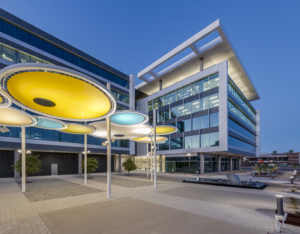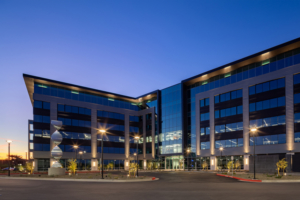CoreNet Global brought together panelists who were instrumental in the planning that led to First Solar’s decision to locate their second US manufacturing facility in the City of Mesa. On March 17, 2011, First Solar announced it was acquiring 135 acres within the Mesa Proving Grounds to build the first phase of a $300 million solar module fabrication plant, their second facility in the U.S. To meet growing demand for photovoltaic solar panels, First Solar needed construction underway in 2011, with four manufacturing lines in production by late 2012.
CoreNet Global
Tues June 7, 2011, Phoenix Country Club
11:30 a.m. – 1 p.m.
Moderator:
Karrin Kunasek Taylor, DMB, Exec. VP, Chief Entitlements Officer
Panelists:
Steve Krum, First Solar, Director of Communications
Barry Broome, Greater Phoenix Economic Council, CEO& President
Mayor Scott Smith, City of Mesa
Background: In 2006, DMB bought 3,200 acres of the former 5,000-acre General Motors Desert Proving Grounds located in the City of Mesa and previously used for hot weather vehicle testing. DMB’s acreage became the Mesa Proving Grounds: the last significant, privately-owned contiguous land holding in Metro Phoenix’s southeast Valley. The City of Mesa has actively pursued employers for their Gateway Planning Area, which includes the Phoenix-Mesa Gateway Airport, ASU Polytechnic campus, and major freeway access.
Kunasek-Taylor: Mesa Proving Grounds is unique… it is a strategic site east of the Phoenix Mesa Gateway Airport which offers three runways that can land any aircraft in the world. This airport is one of the priorities of the Federal Aviation Authority for future funding. The adjacent ASU campus now has 10,000 students and plans for growth up to 30,000 students. 11% of the jobs in Metro Phoenix are in the Southeast Valley, and ADOT (Arizona Department of Transportation) will soon award the contract for first phase of construction connecting the 202 freeway to the airport. Zoning for Mesa Proving Grounds future development was based upon dividing the 3,200 acres into nine development unit plans, with pre-approved densities and uses. First Solar announced in the fall of 2010 that it was hunting for new manufacturing space capable of accommodating 5,000 employees.
Krum: Why was Mesa selected, when a solar panel manufacturing facility can be located anywhere since the manufacturing process doesn’t need sun? First Solar needed immediate availability of land and a quality workforce. There was a sense of urgency and commitment by Barry Broome of GPEC, the leadership of the City of Mesa and its economic development team, and DMB had a fantastic master plan for the Mesa Proving Grounds. With manufacturing facilities around the world, First Solar has choices. But it was very clear that the City of Mesa wanted First Solar. A lot of people here were trying to help us achieve our vision. Our fastest growing market right now is the Southwestern United States. The Agua Caliente project (290 megawatt solar photovoltaic generating facility) in Yuma County, southwestern Arizona. — we want to be in close proximity to projects like that. Pacific Gas & Electric has contracted to purchase Agua Caliente’s output for 25 years. There will be more projects like this to serve California, since utilities there have to meet California requirements for alternative energy sources.
Broome: In 2007 we saw the unprecedented spike in solar — we saw an incredible opportunity for Arizona. We went after every German solar company, but lost them (locating) to states like Oregon, New Mexico, Texas and California. It’s a capital intensive industry: we’ve got to help them recover their capital, help lower their operating environmental over 10-15 years, and we’ve got to deliver talent. Most of the guys who run solar companies are ex-Intel and Motorola guys. So we put together a platform that delivered engineering, real estate, and demand. On a policy level, we removed personal property taxes for a ten year period. With this program, the state of Arizona and the city of Mesa will make millions of dollars of corporate taxes in the coming years. There are many related solar supply chain companies coming into this market – we expect to announce another 16 solar related companies in the coming 18 months. The price of solar electric power will continue dropping, as technology improves. It was 28¢/kwh; not it’s down to 14¢/kwh, and it will go lower. This means more demand for solar.
Smith: The First Solar project is a great example of how economic development should work. Companies go to places where they can succeed. Tax policy is not an end-all. State policy has to be in place. Business attraction tools are set at the state level. Barry helped create the policy level, which gave us the tools. The three key things that make a deal are infrastructure, people, and real estate. We decided this was a deal that we were not going to lose. We brought out every resource we have in the City of Mesa. We needed 1 million square feet, all entitlements, and fast tract for opening in 2012. We needed the right zoning — that’s why DMB was part of this. I’ve got to give DMB credit for being flexible and having the right vision to make this work. They did not make money on this deal. It was a giant leap of faith to make the community better. The complexity of this type of structure — power, roads, water — Mesa passed a bond issue two years ago that allowed us to accommodate this size of project. We were able to solve the problems and create a environment so that First Solar couldn’t say no. First Solar will succeed, and others will come. This truly was a team success — state, county, city and private companies.
For more information about First Solar and more, visit:
firstsolar.com
dmbmesaprovinggrounds.com
mesaaz.gov
corenetdesertmtn.org



